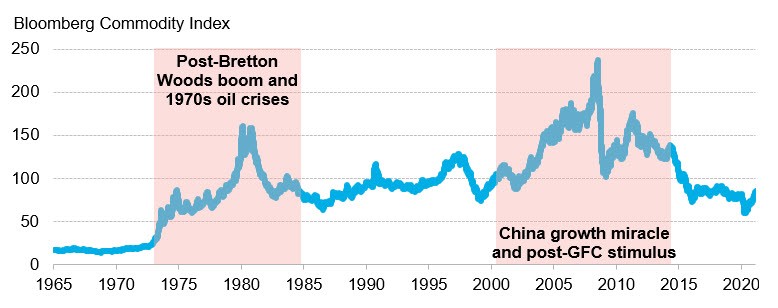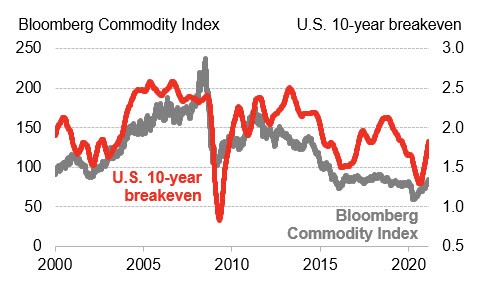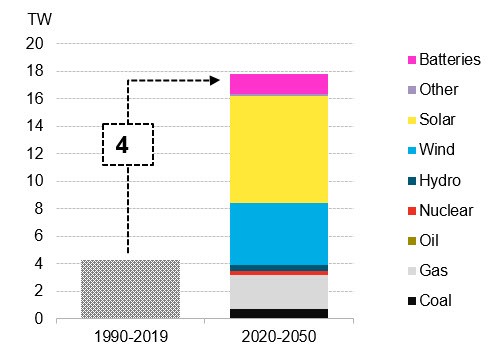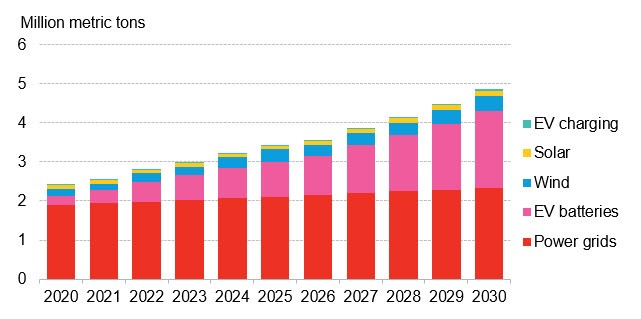The next commodity supercycle?
Commodity prices, from copper to corn, are rallying to multi-year highs. A confluence of factors is driving the upswing, with many markets appearing to be in a structural deficit just as the post-pandemic economic recovery gathers pace. A debate is underway around how prolonged the current bull market could be, with many commentators speculating that we are entering a ‘supercycle’.
We believe that current market conditions indicate we are entering a period of elevated commodity prices, in particular for metals, but it’s not yet clear if the upswing will be sufficiently large and/or prolonged to qualify as a ‘supercycle’. Nonetheless, higher prices will impact the strategic outlook for the energy and mining sectors and will influence the speed and shape of the energy transition.
Bloomberg Commodity Index, 1965-present

Source: BloombergNEF. Note: Iron ore or steel are not part of the BCOM Index.
There have been two occasions in the past 50 years which have been termed commodity ‘supercycles’ – the end of Bretton Woods system in the early 1970s, ending with the 1986 oil price collapse; and the period from 2001 to 2014 marked by rapid growth in China, the U.S. shale boom, and stimulus following the global financial crisis (GFC).
The hallmark of previous supercycles is the emergence of significant growth in demand that exceeds expectations and leads to supply deficits because previous investment was insufficient. Compounding factors, such as dollar devaluation, stoke the rally and prolong the cycle. The key difference between a cyclical upswing and a supercycle, however, is the extent to which demand overwhelms supply, and the length of time that it takes to bring more supply to market.
The conditions we see in the market today could be the recipe for a new supercycle:
- Underinvestment, prolonged by ESG concerns: Several years of declining investment in major commodity markets, such as oil and basic metals, were compounded by the Covid-19 pandemic which led to a significant curtailing of capital spending plans. Even as demand recovers, oil and gas and mining companies are under continuing pressure from investors to maintain capital discipline, pay down debt, and increase their focus on ESG standards. This will slow investment decisions, limit the types of resources and regions companies can explore, and reduce capital available for new supply projects.
The return of inflation: Since late last year, inflation expectations have jumped on confidence in the post-pandemic recovery. The U.S. 10-year breakeven hit 2.26% in February, the highest level in over six years. Historical correlation has consistently shown that inflation and commodity prices move broadly in line with one another. Central bank regulators around the world are also signaling tolerance for higher inflation. A prolonged shift in medium-term inflation expectations to back above 2% is likely to feed into higher commodity prices.
Correlation between commodity prices and inflation expectations

Source: BloombergNEF. Note: 10-year breakeven is the difference in the yield of a nominal 10-year treasury and an inflation protected 10-year treasury. Chart shows daily closing values for commodity index and 200-day moving average for breakeven rate.
Green infrastructure boom: BNEF estimate that $800 billion out of over $12 trillion in post-pandemic fiscal stimulus specifically targets ‘greener’ infrastructure and manufacturing. Low carbon transition is a key theme driving infrastructure investment over the next decade. BloombergNEF estimates that net new power generation capacity additions will total 17.8 TW in next thirty years, four-times as much as was installed in the last thirty years, most of this capacity growth in wind and solar. To connect all this new capacity, a further 48 million km of power lines need to be built by 2050, resulting in a 41% increase in aluminum and 89% increase in copper demand.
At the same time, the turnover of the passenger vehicle fleet to electric vehicles (EVs) is set to accelerate, with annual sales of EVs reaching 25 million by 2030 and 55 million by 2040. The accompanying boom in batteries will increase demand for nickel eleven-fold, lithium eight-fold, and copper seven-fold.
In face of this growing demand, many metals (most notably, copper and Class 1 nickel) that are already tightly balanced in the near-term, face potentially significant long-term deficits. For other critical but minor (i.e. small volume) metals, like rare earths, cobalt, and tin, global production is highly concentrated in a few regions or among a few companies. While there may be enough supply now, investment into new capacity is uncertain, unreliable, and not transparent. These factors are breeding supply-side uncertainty across metals commodities, which will feed into higher price expectations.
Global net power generation capacity installed

Source: BloombergNEF New Energy Outlook 2020
Copper demand in clean energy technologies

Source: BloombergNEF
But, there are also several reasons to discount the supercycle thesis:
- Risks to global growth: The world economy is emerging from the pandemic hobbled by high levels of sovereign and corporate debt, and high levels of unemployment in many countries. These uncertainties indicate the need for caution, as what may be a short and sharp recovery off the back of stimulus programs and pent up consumer demand, risks fading into a longer-term economic malaise.
- China won’t come to the rescue this time: Following the 2008 financial crisis, Chinese stimulus came to the rescue of the global economy with a wave of huge infrastructure programs boosting demand for industrial commodities and supporting global growth. This time, China’s 14th five-year plan is focused on reigning in debt-driven growth, reducing industrial capacity, in favor of rural upgrading and improving consumption.
- High oil prices will be self-limiting: The flip side of a green investment boom is the impact on demand for fossil fuels. We expect oil demand growth to slow and for it to peak in 14 years times, in 2035. We also expect gasoline demand to peak even earlier, in 2030. The prospect of peak oil demand will limit the upside to long-term oil prices. Moreover, if prices were to rise for any period of time, it would accelerate the decline in demand growth and bring forward the peak, meaning higher prices are likely to be somewhat self-limiting. In the nearer-term, OPEC and its partners have amply spare capacity to meet growth in oil demand, and higher prices would eventually trigger a fresh wave of production growth from U.S. shale, limiting the upside to oil prices.
Supercycle or not, higher prices matter
We believe that current market conditions indicate we are entering a period of elevated commodity prices, but it’s not yet clear if the upswing will be sufficiently large and/or prolonged to qualify as a ‘supercycle’. Semantics are less important than the changing narrative, however, with higher prices impacting the strategic outlook for the energy and mining sectors.
Supercycle or not, commodities are set to be the driver, not the consequence; and the beneficiary, not the victim of the energy transition over the next decade.